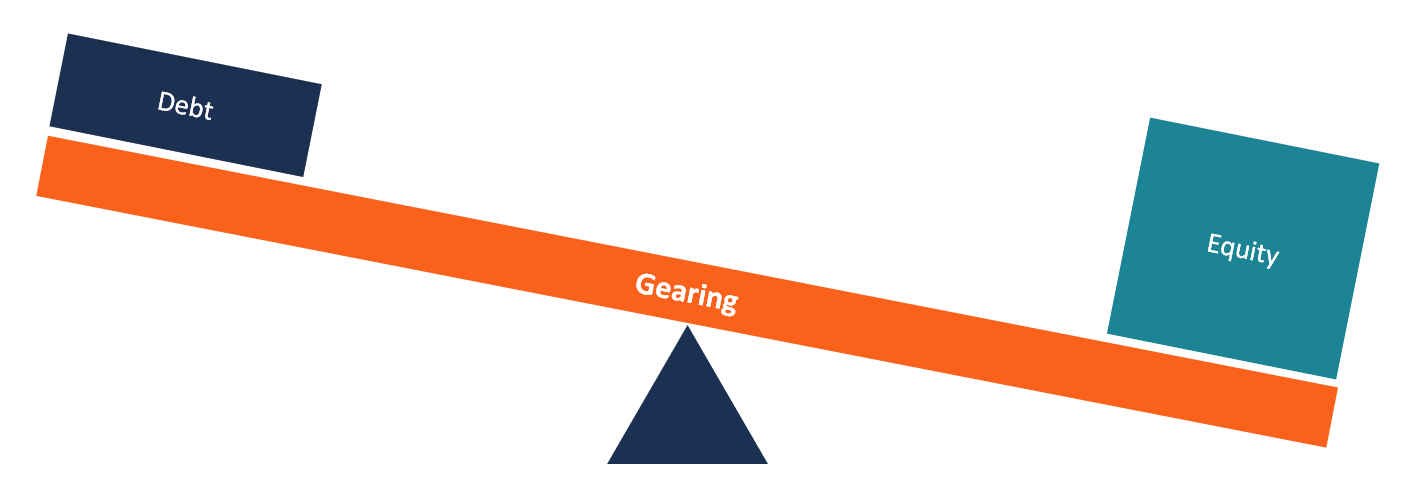When evaluating a company’s financial health, one of the key metrics to consider is the gearing ratio. Whether you’re an investor making data-driven decisions, a finance student exploring corporate valuation principles, or a business owner aiming to optimize your capital structure, understanding the gearing ratio is essential.
What is Gearing Ratio?
The gearing ratio is a financial metric that compares a company’s debt to its equity in order to assess its financial leverage. Simply put, it measures how much of a company’s operations are funded by borrowed capital (debt) versus owner capital (equity).
High levels of debt compared to equity indicate a high gearing ratio, while lower levels of debt in relation to equity demonstrate a low gearing ratio. The most common type of gearing ratio used is the net gearing ratio, also known as the debt-to-equity (D/E) ratio, which evaluates the proportion of total debt to shareholder equity.
Formula for Gearing Ratio
The gearing ratio can be calculated using this formula:
Net Gearing Ratio = (Long-Term Debt + Short-Term Debt + Bank Overdrafts) ÷ Shareholders’ Equity
The result, expressed as a percentage, showcases how dependent a business is on borrowed funds relative to its owned funds.
For instance:
- A gearing ratio of 50% suggests the company has $0.50 of debt for every $1 of equity.
- A higher ratio typically signals greater financial risk, whereas a lower ratio suggests financial stability.
Why is the Gearing Ratio Important?
The gearing ratio provides a snapshot of a company’s financial structure and its risk level. Here’s why this metric is so valuable:
- For Investors:
Investors use the gearing ratio to determine whether a company has a sustainable financial position. A high ratio might signal potential risks like bankruptcy during economic downturns or reduced flexibility for reinvestment. Conversely, a low ratio can indicate stability but might reflect underutilization of opportunities for growth through borrowing.
- For Business Owners:
For business owners, gearing ratios offer insights into how efficiently the company utilizes debt. Borrowing can fuel expansion and drive profitability when managed properly. However, too much debt can lead to financial strain, especially if cash flows are insufficient to cover interest repayments.
- For Lenders:
Lenders rely heavily on the gearing ratio to assess a company’s creditworthiness, i.e., its ability to repay loans. A company with a high gearing ratio is often seen as more financially risky, which might result in higher interest rates or difficulty securing loans.
Different Types of Gearing Ratios
There are several variations of gearing ratios, each designed to highlight specific aspects of a company’s financial positioning. These include:
- Debt-to-Equity Ratio (most common): Shows how much of a company’s operations are funded by debt vs. equity.
- Equity Ratio: Highlights the proportion of shareholder equity in total assets.
- Debt Service Ratio: Measures a company’s ability to meet its debt obligations.
- Debt-to-Capital Ratio: Focuses on the proportion of debt in the overall capital employed.
Understanding which ratio to use depends on the specific financial analysis or industry benchmark you’re working with.
What is a “Good” Gearing Ratio?
The definition of a “good” gearing ratio depends on:
- The Industry: Companies in capital-intensive industries, like utilities or manufacturing, tend to have higher gearing ratios because they rely on heavy borrowing to finance large assets.
- The Business Type and Stage: Established companies may handle higher levels of debt more effectively compared to startups or smaller businesses.
General Guidelines:
- Below 25%: Low-risk, financially stable. This is typical of businesses with conservative strategies or minimal need for debt financing.
- Between 25% and 50%: Considered an optimal range for most established companies. It strikes a balance between leveraging debt for growth and maintaining low financial risk.
- Above 50%: High gearing. The company is heavily reliant on debt, increasing its financial risk. While this may work for capital-intensive sectors, it can be a red flag for other industries.
It’s critical to compare gearing ratios within the same industry as different sectors have varying benchmarks for “healthy” leverage.
Pros and Cons of a High Gearing Ratio
Advantages:
- Capital for Growth: Debt enables companies to fund new projects, expand operations, or launch new products without diluting equity shareholders’ ownership.
- Lower Costs of Capital: Borrowing is often cheaper than equity financing due to tax deductibility of interest expenses.
- Boosted Profits (if managed well): Proper utilization of debt can generate returns that outweigh the cost of interest.
Disadvantages:
- Financial Risk: High leverage increases exposure to interest rate changes or revenue fluctuations, potentially leading to financial distress.
- Reduced Flexibility: Companies with high debt may have less room to maneuver during economic downturns.
- Creditor Pressure: Heavy reliance on debt can mean strict adherence to lender-imposed covenants, limiting strategic choices.
How to Use Gearing Ratio Effectively
To make the most of gearing ratios in financial decision-making:
- Compare Across Companies within the same industry or similar business models to get relevant insights.
- Combine with Other Metrics like operating margins, earnings growth, and cash flows to get a full picture of a company’s performance.
- Monitor Trends Over Time to assess whether a company’s reliance on debt is increasing or decreasing, and why.
For example, a high gearing ratio paired with increasing revenue and profitability may indicate strategic borrowing for growth. On the other hand, a declining cash flow with a high gearing level may signal trouble ahead.
Final Thoughts
The gearing ratio is a vital tool in understanding a company’s financial leverage and risk profile. Whether you’re an investor assessing potential investments, a finance student looking to deepen your knowledge, or a business owner evaluating your financial structure, mastering this metric will empower you to make well-informed decisions.
A balanced gearing ratio tailored to your industry standards and business strategy can help you maximize opportunities while mitigating risks. If you’re ready to take your financial analysis to the next level, start incorporating gearing ratio insights as part of your evaluation toolkit.








